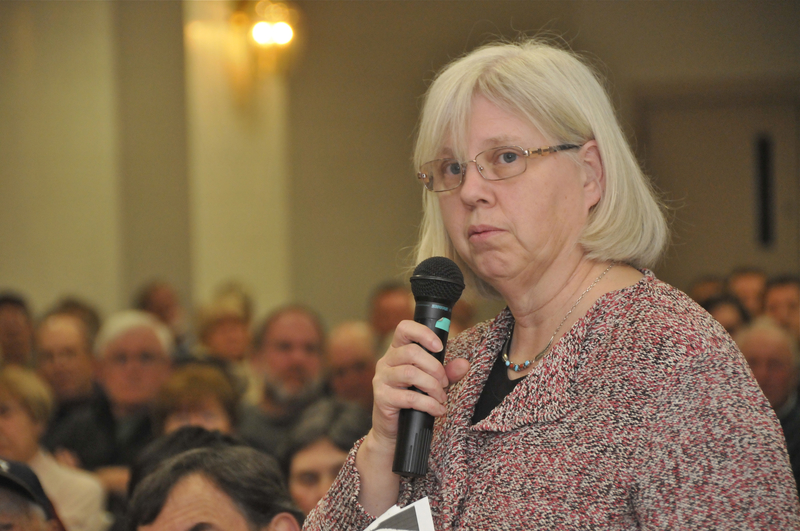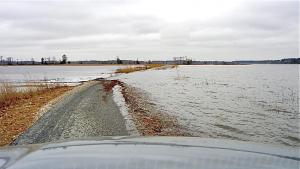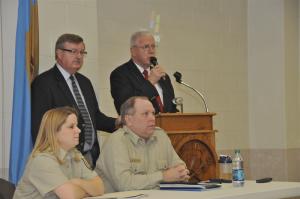Delaware Bay residents crowded a recent meeting about flooding at Prime Hook National Wildlife Refuge, but they left as frustrated as they came.
They learned from state and federal officials there is no short-term plan to fix the breaches that allow tidal flow into the marshes, and no plans can be made at least until the end of the year when a required comprehensive conservation plan is approved by U.S. Fish & Wildlife Service. The free flow of Delaware Bay water contributes to flooding of Primehook Beach and Prime Hook Road and threatens other bay communities.
Refuge Manager Michael Stroeh said filling in the breaches and replacing the dunes - the solution many bay residents want - would be a temporary fix. The breaches are symptomatic of much bigger problems within the refuge's ecosystem. “Rebuilding the dune line is not enough,” he said. “A more sustainable option is needed that we can all live with. We must address the entire natural system in the refuge and not just the breach impoundment to also provide protection to surrounding communities.”
The shoreline in the area of the breaches has receded 500 feet over the past eight decades. In 66 years, from 1926 to 1992, the shoreline between Fowler and Primehook beaches receded about 300 feet, but the past 20 years alone, the shoreline has receded another 200 feet, Stroeh said.
Two of the refuge's four marsh impoundments are slowly becoming engulfed by the Delaware Bay. “We are facing a catastrophic outcome now,” he said.
Unit 2, formerly a freshwater impoundment that is now almost entirely open water, is where the effects are most striking. The breaches at Fowler Beach have allowed for the free flow of bay water for most of the past three years. Most of the marsh vegetation and trees on the uplands around the perimeter of the marsh have died. Most of the protection the marshes long provided for Primehook Beach is gone.
Stroeh called Unit 2 a big bathtub that gets stopped up with saltwater and is never completely drained. Water is also spilling over into Unit 3, another freshwater marsh that backs up to Broadkill Beach.
“The dunes are being cannibalized to feed the marsh; it's the weak link in the system,” he said.
Stroeh said a major change has occurred at Prime Hook over the past few years that has affected the numbers of shorebirds, songbirds, horseshoe crabs and waterfowl.
“We hear from you to please fill the breaches,” said Greg Patterson, Gov. Jack Markell's legislative liaison. “It's seems obvious, but the breaches are symptomatic of a larger problem. The bottom line is, you have the state's attention and concern. It's not a simple fix; it's a complex problem driven by Mother Nature.”
He also told residents the situation does not constitute a state of emergency, which is in answer to a request by the Primehook Beach Organization.
Stroeh said there would be six public meetings to gather comment on the CCP with review by the Delaware Department of Natural Resources and Environmental Control and the U.S. Environmental Protection Agency.
The Jan. 20 hearing at Carlisle Fire Hall, attended by more than 250 people, was scheduled by Sen. Gary Simpson, R-Milford, and Rep. Harvey Kenton, R-Milford, who wanted the public to hear the same presentation they heard from refuge officials.
“We were ready to get the money to repair the dunes, but the state is handcuffed by the federal agency,” Simpson said. “We are pushing hard on the process, and our primary goal is to get that done and restore the dunes.”
The science of the marshes
Susan Guiteras, refuge biologist, said refuge staff had been doing its job taking care of the birds, food and plants within the refuge while drastic changes were occurring.
“Things have been going on beneath the surface that until recently had no monitoring consideration,” Guiteras said.
At one time, all of Prime Hook's wetlands were saltwater marshes, until man-made water-control devices, ditches and levees were built, creating freshwater marshes.
The man-made freshwater marshes are a contributing factor to the decline of the refuge today. Guiteras said the root systems of the saltmarsh perennial plants hold sediment and help to boost the level of the marsh, but the root systems of annual plants in a freshwater marsh do not build a marsh over time.
The marsh has not kept pace with other environmental factors. The accretion rate within the areas of freshwater marsh is half the rate of sea-level rise, so the marsh is struggling to keep up, Guiteras said. On the other hand, the areas of saltwater marsh are keeping pace with sea-level rise.
“When a marsh is changed to freshwater, the nature of the sediment is also changed,” she said. A freshwater marsh is vulnerable to collapse with an influx of saltwater, and it can be very rapid, she said.
She said the average elevation in Unit 2 is 7 inches below where it should be, and Unit 3 has a 10-inch deficit. The refuge has four man-made units, or impoundments.
Residents respond to officials
While officials discussed options and explained the pros and cons of saltwater and freshwater marshes, residents in the audience didn't seem too concerned with the science.
Broadkill Beach resident Jim Williams said the bay communities predate the refuge. “We have to be taken into consideration in the CCP because each day our situation deteriorates. We don't care if it's saltwater or freshwater; what we care about is water level,” he said.
“We are the human part of the ecosystem, and we deserve as much consideration as other species,” said Jack English of Slaughter Beach. “If the Netherlands had proceeded the way we have, they would have lost 25 to 30 percent of their land by now. There was a $350 million [state budget] surplus last year and that would have been a good start to fix the problem.”
Cindy Miller, president of the Primehook Beach Organization, said a short-term solution is needed because residents are being held hostage to the refuge's conservation plan development process, and they have run out of time. “Can the state help us now separate from the federal government and Fish & Wildlife?” she asked. “We are the victims here, and every day it gets worse.”
“The state government will not violate federal law,” Patterson answered. “I understand your frustration.”
Don Clifton of Milford, who owns property in the Prime Hook area, said he has worked for the federal government, and he understands the process. He said it's a matter of getting the attention of the right people. “Government can work quickly. I'm sure there is a parallel track with working on the CCP if the right decision-makers are brought to the table,” he said.
Steve Bennett, a farmer in the Prime Hook Refuge area, said he is seeing crop damage from high tides. “What happens during a four-day nor'easter or hurricane? Am I going to lose my whole farm, and are people in Primehook going to lose their homes?” he asked.
Terri Clifton, who owns farmland near the refuge, asked who was responsible for decisions made at the refuge that have resulted in damage. She was told the damage was caused by acts of nature.
Three options are part of conservation plan
• Marsh restoration would require 7 to 10 inches of dredge spoil pumped into Units 2 and 3 with a need to establish tidal channels. The cost is unknown.
• Maintaining freshwater marshes would require beach replenishment at an estimated cost of at least $7 million with additional maintenance costs every five to 10 years. Repair work would be needed on the refuge's water-control structures, Stroeh said. In addition, he said, the refuge might be competing for the same sand and funding needed by bay communities for replenishment work. Stroeh said restoring the dunes would be in conflict with current refuge policy of allowing natural processes to take place.
• Passive management - or letting nature take its course - would allow the current trend of the marshes converting to open water. Stroeh said this option could result in the loss of 5,000 acres of wetlands - about 55 percent of the total refuge - with an estimated ecological loss of $53 million, not including the loss of recreational opportunities. Stroeh said under this option, wetlands could recover on their own, but the process could take hundreds of years and could be offset by sea-level rise.
Stroeh said the preferred alternative at this point would be marsh restoration, but that nothing is set in stone. When asked if the dunes would be repaired, Stroeh answered: “Right now, I would say no,” he answered. “But if rebuilding the beach is required to rebuild the marshes, I would say yes.”
He also said public input on the plan is important and would be considered before a final decision is made.
Major work not likely to begin until at least mid-2013
Even with the approval of the refuge's comprehensive conservation plan, major restoration work would likely not begin until mid- or late 2013. It will take planning time and time for permits to be approved for whatever option is selected. The permitting process can take as long as six months, said Michael Stroeh, refuge manager.
Depending on the option selected, he said, some work such as planting marsh grass or spartina could begin soon after the plan is adopted. “In early 2013, people would see the restoration plan ramped up higher,” he said.
If the option selected is to restore the open-water areas back to saltwater marshes, that process could take 10 years or more to complete. Stroeh said in other refuge restoration projects, officials have had time to plan before major damage has been done. That's not the case in Prime Hook National Wildlife Refuge. “Mother Nature is dictating this to us, and we have to adapt as we go,” he said.
The time frame does also not include any potential legal action to halt proposed work within the refuge.
State leads effort to take some action now
Greg Patterson, Gov. Jack Markell's legislative liaison, said the state is investigating a second access point to Primehook Beach through a private road located in adjacent Broadkill Beach. The current access point, Prime Hook Road, is prone to flooding at high tide. Patterson said he is aware some Broadkill residents are opposed to the plan, but he said the state would be looking at access through Primehook Beach if the situation was reversed.
He said the Delaware Department of Transportation has applied for a federal grant to widen the road culverts to reduce flooding at the north end of Primehook Beach. He said officials would know if the funding would be available by March 31 and the work could be completed within a year.
In addition, he said, Delaware Emergency Management Agency and Sussex County officials are seeking funding for a flood-control project in the Primehook Beach area. He said Federal Emergency Management Agency officials are expected to visit the area this week. “The cost would go beyond what Delaware normally gets, so there would be some cost to homeowners, and deed restrictions would be required,” he said.























































